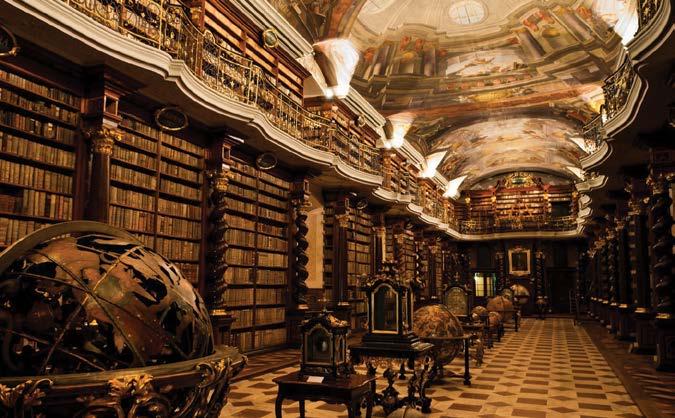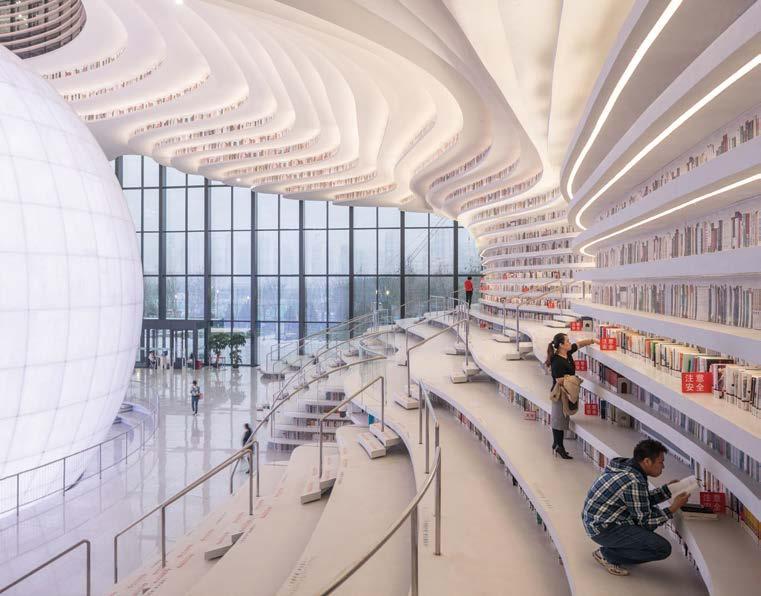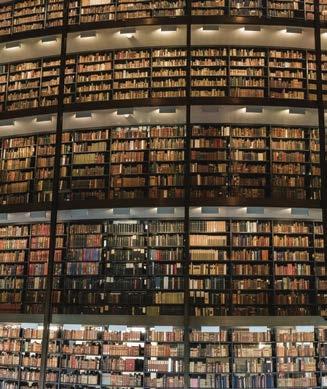
8 minute read
WORLD LIBRARIES The best libraries around the world
WORLD LIBRARIES
THE BEST LIBRARIES AROUND THE WORLD
By Alessandra Maccaferri
Throughout the world there are many libraries which stand out not only for their literary heritage but also for their architecture. Here are 13 listed by country.
For literary lovers and scholars, it doesn’t take much to make a library beautiful, books are enough! However, there are many structures around the world that combine a love for culture with a love for architecture. Whether historic or ultramodern, these libraries are places that inspire and help to dream big. Here are a few. Klementinum Baroque Library In Europe, the Klementinum Baroque Library in Prague, Czech Republic, was built in 1722 as part of a Jesuit university complex. For this reason it houses over 20.000 volumes of mostly foreign theological literature, acquired from the beginning of the 17th century until recent times. Its decorated interior has changed little over the centuries: the ceilings are adorned withfrescoes by the painter Jan Hiebl depicting allegorical motifs of education and portraits of Jesuit saints, prominent representatives of the order,
and patrons of the university. Also of note is the collection of geographic and astronomical globes in the center of the library. It currently contains a number of important and unique works, which have global significance; the historical books are available in a digital library thanks to the collaboration with Google Books. After the lockdown period, the complex enjoyed renewed popularity, as it was among the few libraries that could be visited from home with a convenient virtual tour. The Sandro Penna Library (Perugia, Italy) is named for the city’s poet and was inaugurated in May 2004. Designed by the architect Italo Rota, it was conceived as a large disc entirely made of glass which lights up at night. Due to its architectural form and its location in the center of the San Sisto district, it has become the center
Stadtbibliothek Stuttgart

and reference point for anyone who wants to read, study or stay up to date on general information. The captivating design is partnered with a book heritage that fulfills the needs of different
generations, and is especially rich in the


field of fiction. Particular attention is also paid to children and adolescents, both in the books choices and in the creation of dedicated areas and spaces.
The Stadtbibliothek Stuttgart, the city library of Stuttgart, Germany, was opened to the public in 2011. It is a very modern structure designed by the South Korean architect Eun Young Yiin in the shape of a parallelepiped, with a square base, and where glass elements play an important role. The building consists of nine floors above ground and two underground. The building houses half a million texts, as well as an empty quiet room where people can reflect, with or without books. The library also overlooks the surrounding buildings, a choice made to highlight it as a place to enrich individual knowledge an increasingly important element for society.
In Asia, the MVRDV architecture firm and the Tianjin Urban Planning and Design Institute - TUPDI built the Tianjin Library in Tianjin, China. An oval opening perforated through the building is supported by the Eye, a luminous sphere with an auditorium, which occupies the main stage within the central atrium and expands the perception of space inside. Terraced bookcases that repeat the shape of the sphere create an internal landscape with contours that extend enveloping the facade. In this way, the stepped shelves on the inside are replicated on the outside with each level doubling as a louver.
Tianjin Library Tama Art University Library

With an area of 33.700 m2, the complex functions not only as an educational center, but as a social and cultural space as well.
The Tama Art University Library (Tokyo, Japan) is an architectural work that combines the plastic expressiveness of its forms with a skilful technological use of concrete. Designed by one of the largest architectural firms in the world, Toyo Ito & Associates Architects, it is made of castin-situ reinforced concrete. It is located

VAC Library

in a position where the surrounding environment and green spaces have allowed for a unique architectural design that respects the environment with its many eco-friendly features. The building is spread over three floors, the ground and two floors above dedicated to its function as a library, for a total of 5600 m2. It emulates a contemporary interpretation of a cave and is an extraordinary example of creating free and fascinating spaces. Concrete was also used for the interior design, characterizing the flooring, large seats, sofas, light points and many of the fixed furnishings.
The National Library of Sejong City, in South Korea, was created with the aim of becoming the country’s hub for administrative information. The 21.077 m2 library, located at the far end of the long building of the city’s administrative Bibliotheca Alexandrina complex is designed to hold more than 3 million books and even more digital information. Designed by Samoo Architects & Engineers, it represents a page of a book that is turned upside down. The stunning lake view introduced inside the building creates an exceptional atmosphere for library users with dedicated reading areas. Children’s reading rooms are located on the lower floors to minimize noise while providing direct access to the playground outside the building.
The VAC Library is located in Hanoi, Vietnam and is a project by Farming Architects. It parallels the local people’s custom of creating small natural spaces in their homes, including a place for fish, such as small aquariums or, for the more elite, ponds for Koi carp. Furthermore, the plight of contaminated vegetables in the city means that the need to plant fresh vegetables right in the homes of residents has become imperative. The main feature for the design of the VAC is Aquaponics, a system that combines conventional aquaculture (breeding of aquatic animals) with hydroponics (growing plants in water), in a symbiotic environment. Aquaponics uses the circulating water from a pond to provide nutrients to plants. VAC Library is based on the use of large wooden frames, which give it a certain technical shape and helps to create a flexible and adaptable structure. The spaces are well organized and it is easier to divide them into different


functional areas. The VAC Library is also geared towards an open library space for children. The children of the area and of the other cities can use the spaces to play together, read books and explore the ecological model of the building, learning about the animals within, such as Koi carp and chickens.
of Yale University and houses one of the world’s most important collections of rare manuscripts. Inaugurated in 1963, the library is renowned for its translucent marble facade and the famous glass book tower inside where there are around 180.000 tomes.
The Vancouver Public Library has been dedicated to meeting the lifelong learning, reading and information needs of its residents for over 100 years. Last year it had nearly 6.5 million hits, with users borrowing nearly 9.5 million physical and digital items including books, e-books, movies, music, and magazines. The heart of the library is a large spiraling urban hall that attracts the public both as a quiet place for study and contemplation, and as a meeting point. The stacks of books and services are organized within a ninestory straight central volume, enveloped by a multi-story colonnade containing reading and study areas. The Canadian Library is topped by a public park and a large reading room. The project, which this year celebrates its 25th anniversary, was designed by Safdie Architects.

State Library of Victoria Barr Smith Library
In Africa, the most famous library is the Bibliotheca Alexandrina in Alexandria, Egypt, a modern tribute to the famous

ancient building. It offers enough space for over 8 million books and houses the largest collection of French-language volumes on the continent, and the sixth largest in the world. During this period of distancing the staff is very active in organizing seminars and cultural initiatives online. Kenyatta University Library (Nairobi, Kenya), has a strikingly modern building. It is six floors high and each level has its own specific function (the first floor has a student lounge, the second houses social science books, etc).
In Australia, the Barr Smith Library at the University of Adelaide is characterized by its red brick facade. The building was designed to hold only half a million volumes but, as the collection expanded fairly quickly, more spaces had to be continually added. The library now contains over 2 million volumes and covers nearly 21.000 m2. The State Library of Victoria is immense, also containing over 2 million books. It houses a chess room, with materials on the history and study of the sport, and a series of game tables. After a few years of redevelopment by the Architectus Studio and the Danish architects Schmidt Hammer Lassen, the Library has been reopened all areas to the public; parts of the building that had been closed for decades have been refurbished, including an entire new neighborhood just for children.










